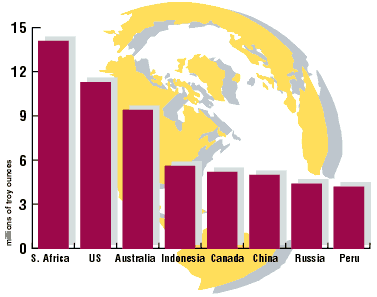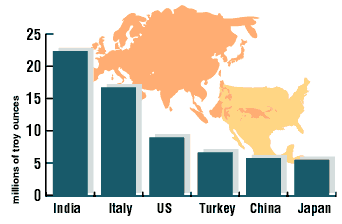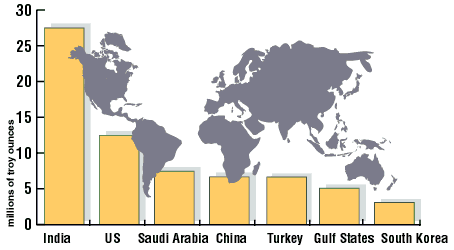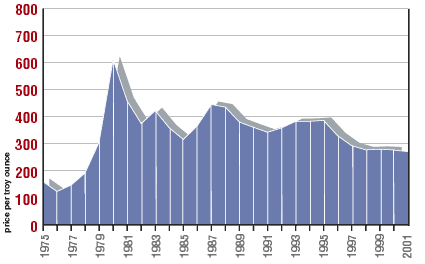
HOT TOPICS LIST
- Strategies
- Stocks
- Buy
- Investing
- Brokers
- Psychology
- Interviews
- Accumulate
- Sell
- Hold
- Spotlight
- Websites
- Candlestick Corner
- Gold & Metals
- Options Trading
LIST OF TOPICS
INVESTING
Heavy (Precious) Metals
06/04/02 01:40:08 PM PSTby Jeff Dufour
The whys, whens, and hows of investing in gold and other precious metals.
| After a long lapse from the consciousness of the investing public, gold is glittering again. Earlier in 2002, the price of gold broke the $300/oz threshold for the first time since 1999. Precious metals mining stocks and gold-laden mutual funds have soared, even as the Standard & Poor's 500 continues to lag. Yet precious metals — gold in particular — are one of the least understood and most controversial investments around. Once thought of as the only true storehouse of wealth, gold now stands very much as an alternative investment. Concerns about the US dollar, the geopolitical situation in the Middle East, the rising price of oil, and the first warning signs of inflation all have led to renewed excitement in these assets. "There's more interest in gold now than in the last 15 years," says Peter Hillyard, senior manager at the London office of ANZ Investment Bank. "Israel, Iraq, additional troops in Afghanistan, higher oil prices — the list is endless. In that environment gold goes up. . . . There's enough going on to add gold as a portfolio diversifier." In times of uncertainty, investors reach for tangible assets. And there's no asset more tangible than gold. Most people still associate it primarily with expensive baubles in Fifth Avenue storefronts or glittering bars locked deep in heavy vaults. One major advantage of gold is that it's one of the only asset classes that is not simultaneously someone else's liability. Further, when you purchase gold, you can safely assume that unlike stocks or even currency, it will always be worth something, as it has been throughout most of recorded history. These attributes make it a historically safe harbor for wealth, and insurance against economic catastrophe.
A HOT COMMODITYIndeed, gold's historical reputation is such that many individuals still believe its prices are dictated, like bonds, primarily by the behavior of investors and hoarders. The reality is that today, gold owes its price more to the other half of its unique dual identity — that of a raw material, a speculative investment. Gold is now first and foremost an industrial commodity, much like oil or livestock, and it is traded as such on commodities exchanges. Each year it becomes more a commodity and less a reserve asset. Of the approximately 115 million ounces of gold put on the market in a given year, 80-85% goes to the manufacture of jewelry. Electronics, optics, aerospace, medical, and dental manufacturers purchase smaller amounts, and still less is bought by individuals for investing or hoarding (see Figure 1). Other precious metals have similarly diverse applications: Silver has uses both in jewelry and in the photographic industry. Platinum can be found in jewelry and electronics. Palladium is used in the catalytic converters in cars.
Figure 1: Worldwide gold fabrication by market sector, 2000. And as with most other commodities, the gold trade is a truly global enterprise. A quantity of gold may be mined in South Africa, bought by a wholesaler in London, sold to a jewelry manufacturer in Italy, and purchased at retail in India (see Figures 2-4). Commodities traders around the world move gold bullion 24 hours a day. The London market, the oldest in the world, fixes the price twice each day, at 10:30 am and 3:00 pm local. The New York Mercantile Exchange opens as London sets the day's second fix. Other important markets reside in Zurich, Sydney, Hong Kong, and Tokyo.
Figure 2: Top gold-producing nations, 2000.
Figure 3: Top gold-manufacturing nations, 2000.
Figure 4: Top gold-consuming nations, 2000.
A LIST OF DEMANDSBut what accounts for the change in prices from fix to fix, week to week, and month to month? Simple supply and demand, as influenced by producers, wholesalers, and buyers. Remember the villain Auric Goldfinger of James Bond fame? He sought to influence prices on the supply side by making radioactive the holdings at Fort Knox, thereby boosting the value of his own gold. In reality, however, the supply of gold remains relatively constant. In a given year, miners extract about 85 million ounces of gold from the earth, and another 15 million ounces of scrap are recycled. The central banks of various nations make available an additional 14 million ounces or so per year. Thus, most of the action that influences prices is on the demand side. Demand forces include industrial needs, the cyclical demand for jewelry from season to season, economic conditions, and investment trends. During marriage season in India, for example, increased demand for gold jewelry drives the price up. Should a nation's currency collapse, prices will likewise rise as its citizens run for safer stores of wealth. A savvy gold trader is an expert at capitalizing on these long- and short-term fluctuations to maximize profits and minimize risk. In order to deliver any product to consumers, manufacturers need certain raw materials. Enter an international gold bullion trader. His job is to obtain the metal from a producer or central bank, and provide it to the manufacturer that needs it. Fred Bogart, managing director of HSBC Bank's Global Precious Metals office in New York, says: "Gold is a business. If somebody wants it, we try to provide it for them, mainly at the wholesale level." Why don't producers bypass the markets and sell directly to manufacturers? For one, trader/wholesalers are often part of a larger financial services company and can thus provide loans, financial expertise, and brokerage services to their industry clients. But more important, traders allow producers to hedge the sale price of their gold out to as many as 10 years through options, forwards, spots, and other mechanisms designed to mitigate long-term risk and reduce volatility. This allows producers to reap the greatest profits, despite any interim fluctuations in price. Bogart emphasizes that regardless of price, gold's natural beauty and reputation as a symbol of luxury makes it by far the most popular of the precious metals. "People love to trade these metals, [but] they love to trade gold the most," he said.
DOOMSDAY SCENARIO?So how can you make gold and its dynamics of supply and demand a useful part of your portfolio? Most fundamentally, gold tends to be a safe haven in times of economic instability — a hedge against volatility, inflation, or even economic collapse. Germans ran to gold after World War I during the hyperinflation of the Weimar Republic. Even today, some American investors diversify their portfolios with precious metals in order to mitigate risk. Metals are one of the few investments that correlate negatively against the dollar; that is, as the dollar weakens, precious metals prices tend to rise. Perhaps more important, metals are often negatively correlated against the stock market as well. One group of commentators, often called "goldbugs," has seized on this inverse relationship. The most noteworthy members of this school, James Dines and Howard Ruff, made names for themselves by anticipating the gold boom of the late 1970s. But since then, their dire predictions of economic collapse have largely fallen on deaf ears, as most mainstream advisors have dismissed them as relics of the past, subscribers to a quirky brand of antigovernment ideology. While most investors are not so extreme, it is precisely this sense of trepidation that has blazed the way for metals' recent resurgence. Economic troubles in Japan have caused a run on gold in that country. And in the US, gold purchases have shot up as investors remain concerned about the fate of their assets in stocks. David Mallalieu, a gold analyst at Scotia Capital, opines, "The dollar has just started to show its cracks."
SHOULD YOU GO FOR THE GOLD?More so than most other investments, the price of gold and other metals moves in fits and starts. Historically, prices rise only two years for every 10 years that the price drops. (See Figure 5.) Those gains can be dramatic, however. Beset by the weak economy and double-digit inflation of the Jimmy Carter years (1977-80), so many Americans rushed to gold that its price topped $850/oz in 1980. Shortly thereafter, however, it began a long, steady decline before settling in at about $270/oz in the late 1990s. The stock markets rose some 1,500% during the same period, while the dollar remained strong, depressing demand for gold as an asset, or even as a diversification instrument.
Figure 5: Average yearly gold prices, 1975-2001. During the 1990s, precious metals mutual funds lost nearly 7% per year on average. But since the onset of the troubles in the US stock market, including September 11, gold has flourished, jumping well above the magical $300/oz level. While the year-to-date (YTD) performance of the S&P 500 languishes at -6.61% as of May 30, Morningstar's Precious Metals fund category checks in at a robust 77.42% YTD, while its Natural Resources category has gained 14.04% YTD. Nevertheless, gold is not the panacea it once was. For starters, our economic situation is nowhere near as dire as it was in the late 1970s. Second, the dollar still remains one of the world's strongest currencies. Fewer investors see gold as a necessary ingredient in their portfolios, so its prices will remain relatively modest, despite the recent spike. UBS Warburg predicts that gold will continue to hover around the $300 level at least through 2003. Carmen Petote, a financial advisor in Pittsburgh, explains that we're "victims of our most recent memories." Looking back to the experience of the 1970s and early 1980s, he says, many recent investors in gold equities expected a return of 150% or more, rather than the 40-50% they've gotten.
THE LINEUPTo help you sort through the maze of gold investing, here is a rundown of the major alternatives (see Figure 6):
Figure 6: Precious metals investments at a glance.
CONCLUSIONGold's remarkable long-term stability makes obvious its place as a diversification tool or in a conservative portfolio. But even those who are bearish on metals would do well to understand the business and economic forces that dictate its ups and downs. Petote notes that the average yearly return of gold investments — about 3% — basically mirrors the rate of inflation over the long haul, similar to a short-term bond. Still, gold will likely always maintain its value. Think of it as the ultimate insurance policy for your portfolio, and the way to go if you're concerned about a financial or political crisis. It could be just the bit of bull that a bearish portfolio needs.
Jeff Dufour is a freelance writer based in New York. He may be reached at jgduf@yahoo.com. Chart data courtesy of The Gold Institute
Current and past articles from Working Money, The Investors' Magazine, can be found at Working-Money.com. |
PRINT THIS ARTICLE

Request Information From Our Sponsors
- StockCharts.com, Inc.
- Candle Patterns
- Candlestick Charting Explained
- Intermarket Technical Analysis
- John Murphy on Chart Analysis
- John Murphy's Chart Pattern Recognition
- John Murphy's Market Message
- MurphyExplainsMarketAnalysis-Intermarket Analysis
- MurphyExplainsMarketAnalysis-Visual Analysis
- StockCharts.com
- Technical Analysis of the Financial Markets
- The Visual Investor
- VectorVest, Inc.
- Executive Premier Workshop
- One-Day Options Course
- OptionsPro
- Retirement Income Workshop
- Sure-Fire Trading Systems (VectorVest, Inc.)
- Trading as a Business Workshop
- VectorVest 7 EOD
- VectorVest 7 RealTime/IntraDay
- VectorVest AutoTester
- VectorVest Educational Services
- VectorVest OnLine
- VectorVest Options Analyzer
- VectorVest ProGraphics v6.0
- VectorVest ProTrader 7
- VectorVest RealTime Derby Tool
- VectorVest Simulator
- VectorVest Variator
- VectorVest Watchdog






